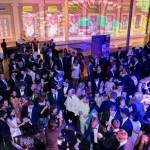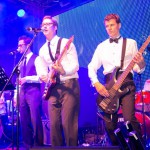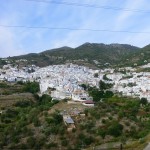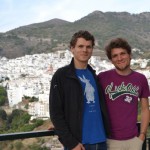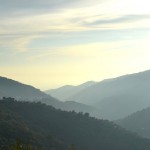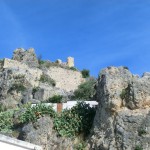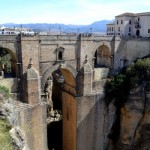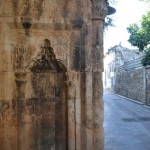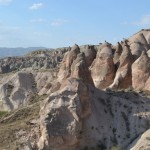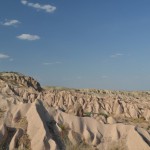After Rhodes, I headed back to Turkey, specifically to Fethiye. Fethiye itself is a somewhat bigger town on the Mediterranean coast, with a rather big marina. The town itself is not very interesting, except for an old amphitheater there is not much “old town” left – the area called “old town” on the maps is more a collection of overpriced restaurants and bars. However, there are quite a few interesting things to see in the surroundings, and the city itself has its charm as well: one example of that is the fish market. On the fish market, you can buy fresh fish and other seafood from stalls in the middle of the market, and then you can head to one of the restaurants surrounding the market stalls which will fry or grill the fish for a relatively small fee and provide bread and salad on the side – a really inexpensive, fresh and delicious seafood dinner!
Above the town, there are some Lycian tombs carved into the rocks some 2400 years ago – quite an impressive sight, with a very nice view over the natural harbour of Fethiye. Further up in the mountains, about 9 km from Fethiye (which I hiked, sweating quite a lot at constantly over 30°C), lies the “Ghost Town” of Kayaköy. As part of the resolution of the Turkish-Greek conflict in the Turkish War of Independence (1926), Turkey and Greece exchanged some parts of their population: Orthodox Greeks moved from Turkey to Greece, and Muslim Turks moved from Greece to Turkey. Because of the disparities in numbers and other factors, Kayaköy, which was formerly a Greek settlement of ~4000 houses, was abandoned and is now virtually uninhabited – only a few restaurants catering to tourists remain. It is quite interesting, how in not even a hundred years a town can decay: Many houses have completely collapsed, and the buildings that are best preserved are the churches and chapels of the town – presumably because they had stone (as opposed to wooden) roofs, which made them structurally much more stable.
Another day trip from Fethiye took me to Saklıkent Gorge, which was really another quite fascinating natural site. The gorge is quite literally a deep crack in the mountain, which is so narrow that even the hot August sun can’t fully heat it up. It is flooded by water, which contains so many minerals and mud particles that it is quite opaque. To walk through the gorge, you have to constantly wade in knee-deep, cold water, which was extremely refreshing in this heat.
The next stop after Fethiye was Kaş, further to the east along the Mediterranean coast. Kaş is a nice little town, and very laid-back. It has a nice little harbour, with many small restaurants, some of which serve really amazing Meze (small dishes) – albeit at quite touristy prices. From Kaş, I went to Patara, which has an incredibly large and nice sandy beach, and took a boat tour to the “sunken city” close to Kekova. Here, the ancient city of Simena was destroyed in the second century AD by a devastating earthquake, and some parts of the city are now located below the surface of the sea – our boat had little windows in the bottom so that you could look down into the amazingly clear water, and see parts of houses and lots of amphorae on the ground. Also, there were plenty of opportunities to swim from the boat (not among the ruins though).
After Kaş, I went to Çıralı, which is basically a big collection of hotels and pensions close to the beach, but offers another quite amazing natural phenomenon: The eternal flame of Chimaera. On the mountains above Çıralı, the rocks emit gases which combust upon contact with the air. The flames can be seen from the sea by night and have been used by seafarers for navigation. The fire has been burning for at least 2500 years, and is said to be the origin of the greek myth of the Chimaera, which was a monstrous fire-breathing creature. I walked up the steep, rocky path to the flames after sunset, and was quite impressed by the phenomenon, especially considering that some 2500 years ago Greeks and Romans looked at these same flames coming out of the rock and tried to make sense of them.
I now have reached Antalya, the last stop on the Mediterranean coast. After Antalya, I will fly to Ankara and move on to Cappadocia from there.
Some pictures follow.
-

-
Fethiye: Lycian Rock Tombs
-

-
Fethiye: Lycian Rock Tombs
-

-
Fethiye: View over the City from Rock Tombs
-

-
On the road to Kayaköy: Shepherd
-

-
Kayaköy
-

-
Kayaköy: Church
-

-
Fethiye: Fish Market
-

-
Saklıkent Gorge
-

-
Saklıkent Gorge: Rock Formations
-

-
Saklıkent Gorge
-

-
Amazing Water Close to Sunken City
-

-
Swim Break
-

-
Eternal Flame of Chimera
-

-
Eternal Flame of Chimera

